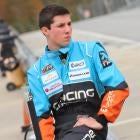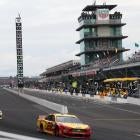
Garrett Lowe had a terrible predicament on his hands. A mechanical engineering student at the University of North Carolina-Charlotte, Lowe had a run of three midterms in three days at the end of September, including one on the evening of September 26.
Taking that exam, however, would have meant missing out on the championship race in the eNASCAR Coca-Cola iRacing Series, where Lowe was one of the Championship 4 competing for a $100,000 prize and the right to be called a NASCAR champion.
Getting out of an important exam is a tough ask, and it's even tougher when you're asking out so you can go and do what most educators would simply belittle as "playing video games". But thanks to a letter from Steve Phelps -- the president of NASCAR -- Lowe had no problems at all.
It’s not every day you need a note from @NASCAR to miss midterm exams so you can race for a championship at the @NASCARHall! pic.twitter.com/hYByuMdvWF
— Garrett Lowe (@GarrettLowe_6) September 25, 2023
In an era where eSports and competitive gaming have become enormously lucrative and enjoy unprecedented legitimacy, sim racing has become serious business in NASCAR. And that's in large part because, unlike most all other eSports, sim racing has become an increasingly viable gateway to great opportunities at the very highest levels of the real thing.
When NASCAR Cup Series star William Byron was coming through the ranks, much was made of how he got his start in racing through iRacing, a subscription-based motorsports simulation platform that has become ubiquitous throughout the racing world. Once Byron opened the door, others -- Rajah Caruth, Parker Retzlaff and Kaden Honeycutt to name a few -- followed through by going from racing on their computers to racing in NASCAR's top three national touring series.
"I feel like the odds were stacked against us and me. The odds are stacked against me, kind of the iRacing kid that comes in, doesn't know how to drive real cars, hasn't ever raced till he was 15," Byron said prior to the NASCAR Cup Series Championship Race. "I feel like the odds were against me to have this kind of success when I came in the sport. I got a lot of criticism because of how I kind of came in."
Thanks to the example of Byron and others in and beyond NASCAR -- including Jann Mardenborough, whose journey from playing "Gran Turismo" to being a professional sports car racer was popularized through the movie of the same name -- the paradigm has now shifted to who will be the next driver to go from sim racing to racing in real life. And finding that driver and giving them the opportunity to translate their skills from sim seats to an actual cockpit has become the domain of organizations such as Racing Prodigy.

Earlier this month, Lowe was one of 12 drivers from nine different countries to participate in Racing Prodigy's Prodigy Week at Atlanta Motorsports Park. While receiving coaching and training from multiple real-life racers, Lowe was put to the test behind the wheel of a Radical SR1, taking his racing skills to the next level after coming up through iRacing's ladder system to the highest level of NASCAR sim racing -- one that has become increasingly sophisticated as sim racing has gone from a mere hobby to something that has made racing far more accessible than ever before.
"We started to turn the corner, I think, right after COVID. You could kind of see where I think motorsports platforms realized they had to start picking up sim racing because it has such a large bandwidth," Lowe said in an interview with CBS Sports. "You're talking about something that's reasonably accessible to most people with an Internet connection and power and a computer, which is a good portion of the world.
"For them to be able to pick up on that and move it to a higher platform where you're competing for contracts for driving in a professional series or prize money -- $100,000 to win the Coke Series – is pretty impressive," Lowe added.
Lowe has crossed paths with several drivers who have successfully made their way into NASCAR through iRacing. He competed against Craftsman Truck Series driver Rajah Caruth as part of the inaugural class of the eNASCAR Ignite Series and was teammates with both Parker Retzlaff and Kaden Honeycutt before the two made their way to the Xfinity Series, Truck Series and the CARS Tour, respectively.
For his part, the 22-year-old Lowe currently sees becoming a Cup Series engineer as his most realistic chance at competing at the highest levels of NASCAR. But his dream of racing at NASCAR's national touring series is still one that he holds onto, and one that sim racing is making possible for him. Perhaps far more so than his real racing experience in Legends cars and Bandoleros, as sim racing is fairly free of the financial considerations that often determine success and opportunities at the short track level.
"I think that's where Racing Prodigy's figured out 'Hey, let's just funnel these guys that are super talented and have the skills and the knowledge base'. Because you can be a great driver, but if you don't have a knowledge base on mechanically how cars work or how the dynamics work, you're not gonna understand how to race," Lowe said. "They've really figured out 'Hey, if we take these guys and put them in real cars, you have something special.' They've really figured that out, and I think everyone can learn from that."
What everyone has learned over the past 10 years -- and to a greater extent over the past five -- is that legitimate racing talent can be found and developed through sim racing. After proving a quick study on his way to the top of NASCAR, Byron led the Cup Series with six wins and was NASCAR's best driver in several statistical categories, narrowly missing out on his first championship.
Caruth flashed brilliance in his first full season of Trucks to the point that he was able to earn a ride with Hendrick Motorsports for the Xfinity Series Championship Race. Retzlaff posted one top-five and seven top-10 finishes in his first Xfinity Series season. In 20 career Truck Series starts, Honeycutt has four top-10 finishes driving for smaller teams.
Those examples have shown writ-large how sim racing has become a part of the fabric of motorsports. And they're what allows drivers like Lowe, and others in the Racing Prodigy program and beyond, to dare to dream that their racing ambitions are in their grasp.
"I'm definitely still aiming to make it to the top three series in NASCAR. I feel like that's where I belong, I feel like I have the talent and the capabilities to do that," Lowe said. "And obviously I went to school and learned everything as well, which not everyone can say. There's very few people that have done that. So I feel like I'm a nice, complete package. And I'm gonna hold my goals really high and see if I can get there."


















